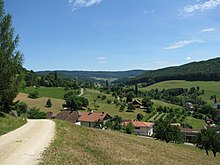Möhlintal
The Möhlintal is a ten kilometer long valley between Möhlin and Wegenstetten in the Rheinfelden district , Canton Aargau , Switzerland . The five communities Möhlin, Zeiningen , Zuzgen , Hellikon and Wegenstetten, which are part of the Möhlintal, have a total of around 15,000 inhabitants.
In the upper valley communities, the valley is also called the Wegenstettertal with a certain pride . This name is used in particular by some associations and associations that only affect the upper communities of the Möhlintal. During the Habsburg era, the area was called the Möhlinbach landscape . The Möhlintal is rarely also called Chläfflital . According to the canton of Aargau, the official name of the valley is only Möhlintal .
Location and description
The valley lies in the north-eastern Table Jura ; that part of the Swiss Jura which, in contrast to its unfolded parts ( folded Jura ), was not folded. The Möhlintal runs practically in a straight line from south-east to north-west and is surrounded by wide, tabular plateaus, into which the valley is deepened. It is traversed by the Möhlinbach , which on a pass between the communities of Wegenstetten and Hemmiken at around 520 m above sea level. M. rises and at Möhlin at 280 m above sea level. M. flows into the Upper Rhine . The municipal areas of Zeiningen, Zuzgen, Hellikon and Wegenstetten form the western part of the Aargau Jura Park, a “regional nature park of national importance”.
Like most of the other Jura valleys in the Fricktal region, the Möhlintal has a relatively narrow valley floor. Thanks to favorable climatic influences, the valley has up to 40 more sunny days than the Swiss Plateau and is mostly fog-free. On August 5, 2003, the private weather service Meteomedia in Möhlin even set a new Swiss heat record of 40.3 ° C.
Thanks to the relatively mild climate and the (wind) protected location of the Möhlintal, the valley is also suitable for viticulture . So the Zeinigerberges at Zeiningen are the varieties on the south side Pinot Noir ( Zeininger Pinot Noir , red wine) and Müller-Thurgau ( Zeininger Riesling x Sylvaner , white wine) grown. Intensive agriculture is predominantly practiced on the fertile soils in the valley, on the slopes and on the plateaus. Of particular importance for the Möhlintal includes among its cherry production . So it is not surprising that the Chriesiberg near Zuzgen owes its name to the countless cherry trees that stand on its plateau. The Fricktaler Kirsch is also a nationally known product.
On the northeast side of the valley lies the extensive Looberg-Wabrig-Hersberg plateau, which separates the Möhlintal from the Fischinger valley , which runs parallel to it . On this plateau is the Fricktal-Schupfart airfield , where the Schupfart Festival takes place every year , an event that is well known in Switzerland. The small winter sports area Föhrlimatt in Wegenstetten , which is located on the western flank of the Tiersteinberg and has a ski lift, attracts numerous visitors from the region in the winter season.
Statistical data
-
Area : 5'272 ha (52.72 km²), of which
- 51% agriculture
- 37% forest
- 11% settlement area
- Population : 15,088 (December 31, 2011)
- Population density : 286 inh / km² (December 31, 2011)
history
Landscape Möhlinbach
The landscape Möhlinbach referred to times when the Fricktal still leading Austria belonged to a subordinate administrative unit of Kameralherrschaft Rheinfelden which for Oberamt Breisgau belonged. It included the places Hellikon , Kaiseraugst , Magden , Möhlin , Mumpf , Olsberg , Wallbach , Wegenstetten , Zeiningen and Zuzgen . The villages in the Möhlinbach region were the main trigger of the black horse war .
population
The Möhlintal has a denominational peculiarity: Möhlin has the largest number of members of the Christian Catholic Church in Switzerland (around 1000). Hellikon, on the other hand, is the municipality with the highest percentage of Christian Catholics in Switzerland (around 20% of the population). Christian Catholic churches and / or chapels are located in Hellikon, Möhlin and Zuzgen.
traffic
The Möhlintal is connected to the public transport network every half hour by the bus route 89 (Möhlin – Wegenstetten) from PostBus Northern Switzerland . The end point of bus line 101 ( Gelterkinden - Hemmiken - Wegstetten), which connects the Möhlintal with the neighboring Basel area , is also in Wegenstetten . A few postbus courses connect the Möhlintal from Wegenstetten with the Fischingertal (via Fricktal-Schupfart airfield). Möhlin train station is on the Bözberg line (Basel-Zurich). The S1 line of the Basel S-Bahn , which runs from Mulhouse in Alsace via Basel to Frick or Laufenburg , runs here. The nearest junctions on the A3 motorway , which crosses the Möhlintal via a viaduct near Zeiningen (Zeininger Viaduct) , are in Rheinfelden (around 3 km west of Möhlin) or Eiken (around 7 km north of Wegenstetten).
Part of the Fricktaler Höhenweg , a regional hiking route , runs through the Möhlintal or along the plateau between the Möhlintal and the Fischingertal .
Individual evidence
- ↑ Dominik Sauerländer: Fricktal - 2 Political and Territorial Development. In: Historical Lexicon of Switzerland . November 9, 2006 , accessed June 8, 2008 .
- ↑ (jrau): Archives. Old archive Fricktal. (pdf) Department of Education, Culture and Sport, Aargau State Archives , August 10, 2006, archived from the original on July 26, 2011 ; Retrieved June 8, 2008 .
Coordinates: 47 ° 31 '12 " N , 7 ° 54' 40" E ; CH1903: 635 588 / two hundred sixty-three thousand three hundred fifty-one
